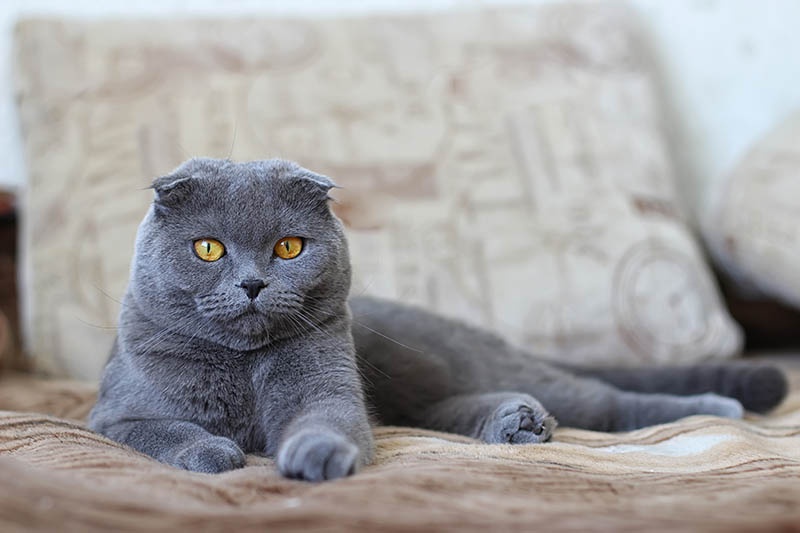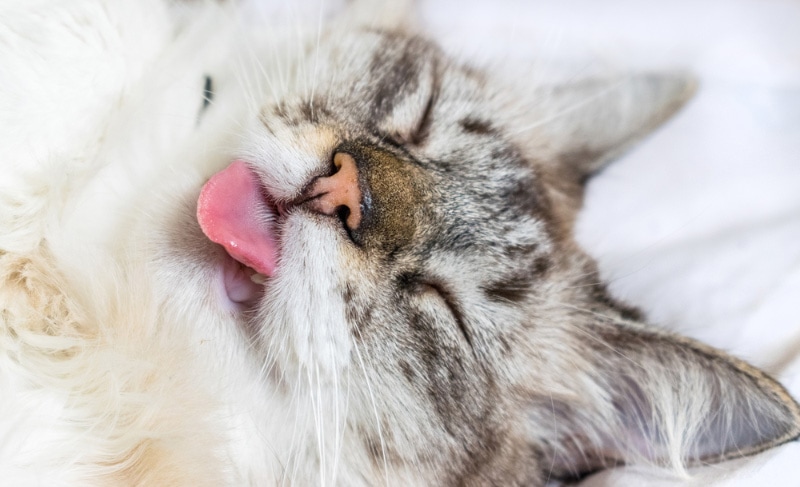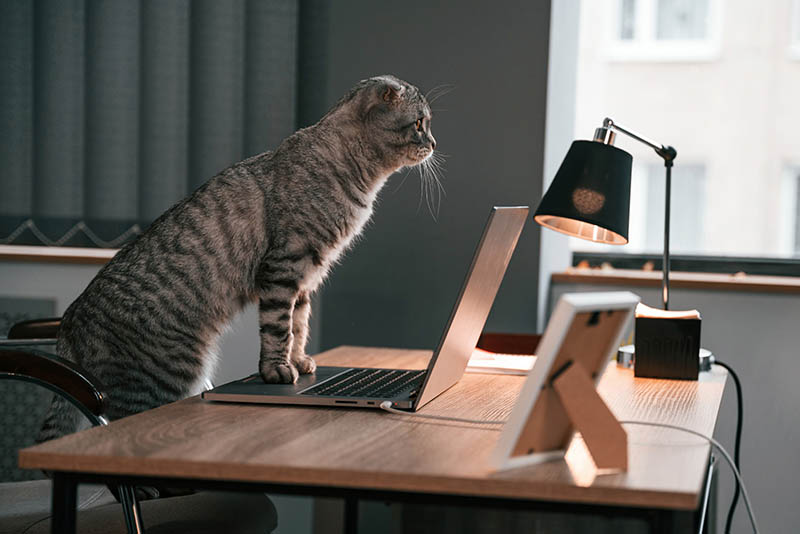Blue Scottish Fold: Facts, Origin & History (With Pictures)
Updated on

The Scottish Fold is one of the most recognizable cat breeds in the country. Those distinct, folded ears give them an adorable, owl-like appearance that makes them one of the most popular cats in the United States. They don’t just have looks on their side, but they also have great personalities and are known for getting along great with people and other pets.
| Height | 7–10 inches |
| Weight | 6–10 pounds |
| Lifespan | 12–15 years |
| Colors | Different shades of Blue |
| Suitable for | Families, apartments, homes |
| Temperament | Affectionate, loyal, needy |
One of the most striking coat colors of the breed is the blue Scottish Fold. These stunning kitties come in varying shades of blue, with light blue being the most sought-after. They feature the same tone all over the body and have striking copper or gold eyes. Keep reading to learn more about these incredible cats and how they’ve made their mark on society.
Blue Scottish Fold Characteristics
The Earliest Records of the Blue Scottish Fold in History
The very first Scottish Fold was a pure white barn cat named Susie. She was born in the Tayside Region of Scotland in 1961 and was quickly recognized as unique because of her downward-folded ears. Susie eventually bred with a tom cat and gave birth to two kittens that also had her distinct, folded ears.
Susie’s owner had a neighbor that was a bit of a cat fancier. This neighbor took one of the female kittens that had this unique trait and named her Snooks. Snooks went on to have a litter of her own and down the line, one of her sons was bred to a British Shorthair, which ultimately led to the official development of the Scottish Fold breed.
How the Blue Scottish Fold Gained Popularity
Within their first couple of decades, the breed was met with both open arms and controversy in different parts of the world. They were most controversial in their homeland of Europe. It all stemmed from the genetic mutation that resulted in the downward-folded ears. Certain health conditions related to the mutation resulted in revoked registration in Europe in 1971.
The Scottish Fold’s popularity only kept growing in the United States and Canada, however. The rare and distinct traits of this cat breed in combination with their loving nature and incredible personalities quickly turned them into sought-after pets. Scottish Fold kittens are considerably more expensive than some other popular purebred cats.
Formal Recognition of the Scottish Fold
The Scottish Fold was granted championship status by The Cat Fanciers Association in 1978. They are also officially recognized by The International Cat Association, or TICA, and Canada’s cat registry, the Canadian Cat Association (CCA.) The breed comes in both short-haired and long-haired versions.
According to the Cat Fanciers Association of the United States, any genetically possible color and pattern and any combination of genetically possible colors and patterns are allowable by the breed standard. The blue coat color will display one level tone from the nose to the tip of the tail, and lighter shades of blue are preferable.
The European Cat Fanciers’ Association revoked the registration of the breed in 1971 and has since refused formal recognition due to osteochondrodysplasia, a genetic mutation that results in the downward fold of the ears. This is a genetic deformity that paves the way for some potentially severe health problems, physical limitations, and predisposition to ear infections, mites, and deafness related to the condition.
Top 5 Unique Facts About the Scottish Fold
1. The Ears are the Result of a Genetic Mutation of Cartilage
As mentioned, the Scottish Fold’s ears are the result of a genetic mutation. This mutation, known as Fd gene, results in osteochondrodysplasia, which affects the development of cartilage. This inheritable disorder is not just limited to the cartilage in the ears but can also affect the development of bone, cartilage, and connective tissue throughout the entire body.
These developmental problems can lead to issues like chronic pain and arthritis. In more severe cases, surgical intervention is even recommended. This condition is considered an autosomal dominant genetic disorder, which means it can be passed on by both males and females and only one parent needs to carry the gene for the kittens to be affected.
2. They Were Once Called Lop-Ears
The breed saw its beginning in 1961 and was first referred to as “lop-eared,” and “lops” because they resembled lop-eared rabbits. The name Scottish Fold became the breed’s official name in 1966.
3. Scottish Folds Cannot Be Bred Together
While Europe discourages the breeding of any individual that possesses the Fd gene mutation, North America discourages the breeding of two Scottish Folds together. Because it is an inheritable condition related to serious health complications involving cartilage, bone, and connective tissue, a male and female Scottish Fold should never be bred together.
The genetic mutation requires only one parent to be affected to result in the downward folded ears. The results of pairing two Scottish Folds could lead to much more severe genetic deformities, making it highly discouraged and deemed cruel. A Scottish Fold is often bred to either the British or American Shorthair in America to produce a litter, though not all kittens will have those distinct ears.
4. Their Ears are Straight at Birth
Breeders have no way of telling which kittens from the litter can be deemed a true Scottish Fold until they reach about 3 to 4 weeks of age. All the kittens are born with straight ears and the Scottish Folds are indistinguishable from their littermates that will have normal, upright ears until the mutation begins to show itself as the ears grow and develop during the first few weeks of life.
5. The Scottish Fold Got Some Serious Internet Fame
A Scottish Fold named Maru managed to become one of the most watched animals on the Internet. Born in 2007, Maru is a YouTube sensation out of Japan that has been active online since 2008. Maru even held the Guinness Book of World Records for the most YouTube video views of an individual animal at one time. He is thought to have kicked off the internet frenzy of cat videos.
Does a Blue Scottish Fold Make a Good Pet?
The blue Scottish Fold makes for an excellent pet for both families and individuals. They are extremely friendly, affectionate, and talkative cats that capture the hearts of their owners. They will thrive as indoor house cats and get along great with children and other pets, including dogs.
They will require more regular ear cleanings to prevent the buildup of wax, dirt, and debris. This will help reduce their risk for bacterial infections and ear mites. They are very clean cats that will groom themselves regularly and will prefer a tidy litter box.
Short-haired Scottish Folds are much more low maintenance with grooming and will only require weekly brushing. Long-haired Scottish Folds will require more frequent brushing, about 2 to 4 times a week to prevent tangling, and matting, and to reduce the risk of skin infections.
The Scottish Fold’s genetics result in a greater risk for several health conditions—including degenerative joint disease, osteochondrodysplasia, and polycystic kidney disease, or PKD. To ensure you get the healthiest kitten possible, you should only purchase from a reputable breeder that puts focus on the health of their cats and the betterment of the breed.
Final Thoughts
The Scottish Fold is a very unique breed with those unmistakable downward-folded ears and an adorable owl-like appearance. The blue Scottish Fold is just one of the many coat colors seen within the breed that comes in all different shades of blue with gorgeous copper or gold eyes. Since the Scottish Fold is the result of a genetic mutation, it is important to research reputable breeders if you are interested in one of these cats.
Featured Image Credit: Inna photographer, Shutterstock












